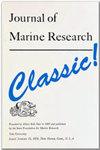中途岛巴塘PLTU沿海水域浮游植物群落结构
IF 0.5
4区 地球科学
Q3 Earth and Planetary Sciences
引用次数: 0
摘要
PLTU批量大型项目开发活动预计将降低水环境质量,尤其是在PLTU批次大型项目周围。浮游植物是水生态系统的重要生物之一,它以初级生产力加热水。浮游植物是一种自养微生物,可以作为水质指标。本研究的目的是了解巴塘PLTU大型项目海滩水域浮游植物群落的结构。所使用的研究方法是一种探索性的描述性方法,而测站则使用有目的的抽样方法。2020年11月至2021年2月,在3个站点进行了3个时段的采样。[UNK]在海里放置一个隐藏站,其中1号站是距离巴塘发电厂大型项目最近的水域,2号站在巴塘发电站大型项目和大海之间的水域,3号站在海上。研究表明,浮游植物共有19个属,分属两个纲,即硅藻科15个属和藻科4个属。浮游植物的抗性范围在2581-10137个细胞/L之间,目前多样性指数为1,61-2,59。平等指数在0.67至0.99之间,显示出广泛而低水平的优势。硝酸盐含量范围为0.28至0.71 mg/L,而磷酸盐含量范围为0.08至0.74 mg/L,因此巴塘PLTU海岸水中的硝酸盐和磷酸盐含量位于海洋生物群的海藻壳之上。[UNK]巴塘PLTU大型项目开发活动的存在预计会降低水环境质量,尤其是巴塘PLDU大型项目周围的水环境质量。浮游植物是水生生态系统的重要生物之一。浮游植物是一种可作为水质指标的自养生物。本研究的目的是确定巴塘PLTU大型项目沿海水域浮游植物的组成、丰度和群落结构。研究方法采用描述性探索法,测站采用目的性抽样法。2020年11月至2021年2月,在3个站点进行了3个时间段的采样。站的位置向大海突出,1号站是最靠近巴塘发电厂大型项目的水域,2号站位于巴塘发电站大型项目和大海之间的水域,3号站位于海上。结果表明,浮游植物共有2纲19属,其中硅藻门15属,恐龙门4属。浮游植物的丰度在2581-10137个细胞/L之间,多样性指数为1.61-2.59,属于中等。均匀性指数在0.67-0.99之间,表明分布均匀,优势度较低。硝酸盐含量在0.28至0.71 mg/L之间,而磷酸盐含量在0.08至0.74 mg/L之间,因此巴塘PLTU大型项目沿海水域的硝酸盐和磷酸盐含量高于海洋生物群的海平面。本文章由计算机程序翻译,如有差异,请以英文原文为准。
Struktur Komunitas Fitoplankton di Perairan Pantai Megaproyek PLTU Batang, Jawa Tengah
Adanya aktivitas pembangunan Megaproyek PLTU Batang diduga akan menurunkan kualitas lingkungan perairan khususnya di sekitar Megaproyek PLTU Batang. Salah satu organisme penting bagi ekosistem perairan adalah fitoplankton yang memaninkan perairan dalam produktivitas primer. Fitoplankton adalah mikro organisme autotrof yang dapat dijadikan sebagai indikator kualitas perairan. Tujuan penelitian ini untuk mengetahui struktur komunitas fitoplankton di Perairan Pantai Megaproyek PLTU Batang. Metode penelitian yang digunakan adalah metode deskriptif eksploratif sedangkan penentuan stasiun digunakan metode purposive sampling. Pengambilan sampel dilakukan sebanyak 3 periode waktu pada November 2020 – Februari 2021 di 3 stasiun. Letak stasiun menjorok ke arah laut yaitu dengan stasiun 1 merupakan perairan paling dekat dengan Megaproyek PLTU Batang, stasiun 2 berada di perairan antara Megaproyek PLTU Batang dengan laut dan untuk stasiun 3 berada di laut. Hasil penelitian menunjukkan bahwa terdapat 19 genus fitoplankton berasal dari 2 kelas yaitu 15 genus dari kelas Bacillariophyceae dan 4 genus dari Dinophyceae. Kelimpahan fitoplankton berkisar antara 2.581-10.137 sel/L dengan indeks keanekaragaman 1,61-2,59 tergolong sedang. Indeks keseragaman berkisar antara 0,67-0,99 menunjukkan persebaran merata dan tingkat dominansi rendah. Kandungan nitrat berkisar antara 0,28-0,71 mg/L sedangkan kandungan fosfat berkisar antara 0.08 – 0.74 mg/L sehingga kandungan nitrat dan fosfat di Perairan Pantai Megaproyek PLTU Batang berada di atas baku mutu air laut untuk biota laut. The existence of the Batang PLTU Megaproject development activity is expected to reduce the quality of the aquatic environment, especially around the Batang PLTU Megaproject. One of the important organisms for aquatic ecosystems is phytoplankton. Phytoplankton is an autotrophic organism that can be used as an indicator of water quality. The purpose of this study was to determine the composition, abundance, and community structure of phytoplankton in the Coastal Waters of the Batang PLTU Megaproject. The research method used was descriptive exploratory method while the determination of the station used purposive sampling method. Sampling was carried out for 3 time periods in November 2020 - February 2021 at 3 stations. The location of the stations protrudes towards the sea, with station 1 being the waters closest to the Batang PLTU Megaproject, station 2 being in the waters between the Batang PLTU Megaproject and the sea and for station 3 be at sea. The results showed that there were 19 genera of phytoplankton from 2 classes, namely 15 genera from the Bacillariophyceae class and 4 genera from Dinophyceae. The abundance of phytoplankton ranged from 2,581-10,137 cells/L with a diversity index of 1.61-2.59 classified as moderate. The uniformity index ranged from 0.67-0.99 indicating an even distribution and a low level of dominance. The nitrate content range from 0.28 to 0.71 mg/L while the phosphate content range from 0.08 to 0.74 mg/L so that the nitrate and phosphate content in the Coastal Waters of the Batang PLTU Megaproject is above the sea level for marine biota.
求助全文
通过发布文献求助,成功后即可免费获取论文全文。
去求助
来源期刊

Journal of Marine Research
地学-海洋学
自引率
0.00%
发文量
1
审稿时长
3 months
期刊介绍:
The Journal of Marine Research publishes peer-reviewed research articles covering a broad array of topics in physical, biological and chemical oceanography. Articles that deal with processes, as well as those that report significant observations, are welcome. In the area of biology, studies involving coupling between ecological and physical processes are preferred over those that report systematics. Authors benefit from thorough reviews of their manuscripts, where an attempt is made to maximize clarity. The time between submission and publication is kept to a minimum; there is no page charge.
 求助内容:
求助内容: 应助结果提醒方式:
应助结果提醒方式:


